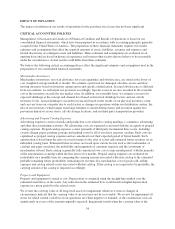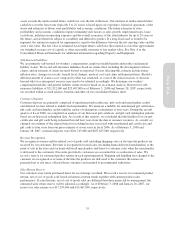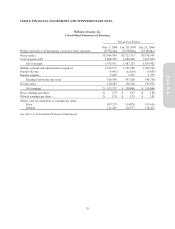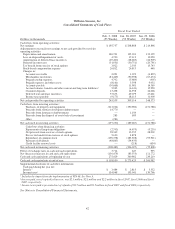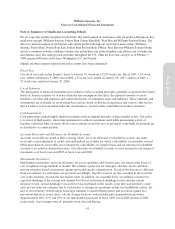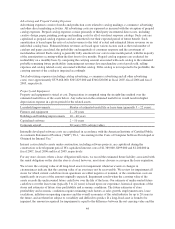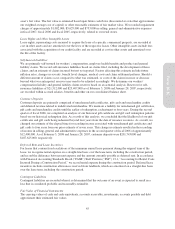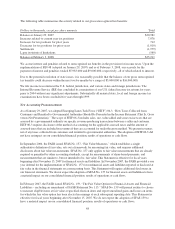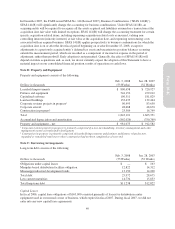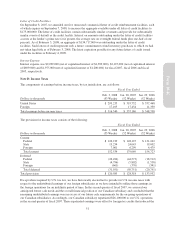Pottery Barn 2007 Annual Report Download - page 53
Download and view the complete annual report
Please find page 53 of the 2007 Pottery Barn annual report below. You can navigate through the pages in the report by either clicking on the pages listed below, or by using the keyword search tool below to find specific information within the annual report.
Williams-Sonoma, Inc.
Notes to Consolidated Financial Statements
Note A: Summary of Significant Accounting Policies
We are a specialty retailer of products for the home. The retail segment of our business sells our products through our five
retail store concepts (Williams-Sonoma, Pottery Barn, Pottery Barn Kids, West Elm and Williams-Sonoma Home). The
direct-to-customer segment of our business sells similar products through our seven direct-mail catalogs (Williams-
Sonoma, Pottery Barn, Pottery Barn Kids, Pottery Barn Bed and Bath, PBteen, West Elm and Williams-Sonoma Home)
and six e-commerce websites (williams-sonoma.com, potterybarn.com, potterybarnkids.com, pbteen.com, westelm.com
and wshome.com). The catalogs reach customers throughout the U.S., while the five retail concepts, as of February 3,
2008, operated 600 stores in 44 states, Washington, D.C. and Canada.
Significant intercompany transactions and accounts have been eliminated.
Fiscal Year
Our fiscal year ends on the Sunday closest to January 31, based on a 52/53-week year. Fiscal 2007, a 53-week
year, ended on February 3, 2008; fiscal 2006, a 52-week year, ended on January 28, 2007; and fiscal 2005, a
52-week year, ended on January 29, 2006.
Use of Estimates
The preparation of financial statements in accordance with accounting principles generally accepted in the United
States of America requires us to make estimates and assumptions that affect the reported amounts of assets,
liabilities, revenues and expenses and related disclosures of contingent assets and liabilities. These estimates and
assumptions are evaluated on an on-going basis and are based on historical experience and various other factors
that we believe to be reasonable under the circumstances. Actual results could differ from these estimates.
Cash Equivalents
Cash equivalents include highly liquid investments with an original maturity of three months or less. Our policy
is to invest in high-quality, short-term instruments to achieve maximum yield while maintaining a level of
liquidity consistent with our needs. Book cash overdrafts issued but not yet presented to the bank for payment are
reclassified to accounts payable.
Accounts Receivable and Allowance for Doubtful Accounts
Accounts receivable are stated at their carrying values, net of an allowance for doubtful accounts. Accounts
receivable consist primarily of credit card and landlord receivables for which collectibility is reasonably assured.
Other miscellaneous receivables are evaluated for collectibility on a regular basis and an allowance for doubtful
accounts is recorded as deemed necessary. Our allowance for doubtful accounts was not material to our financial
statements as of fiscal year-end 2007 or fiscal year-end 2006.
Merchandise Inventories
Merchandise inventories, net of an allowance for excess quantities and obsolescence, are stated at the lower of
cost (weighted average method) or market. We estimate a provision for damaged, obsolete, excess and slow-
moving inventory based on inventory aging reports and specific identification. If actual obsolescence is different
from our estimate, we will adjust our provision accordingly. Specific reserves are also recorded in the event the
cost of the inventory exceeds the fair market value. In addition, on a monthly basis, we estimate a reserve for
expected shrinkage at the concept and channel level based on historical shrinkage factors and our current
inventory levels. Actual shrinkage is recorded at year-end based on the results of our physical inventory count
and can vary from our estimates due to such factors as changes in operations within our distribution centers, the
mix of our inventory (which ranges from large furniture to small tabletop items) and execution against loss
prevention initiatives in our stores, off-site storage locations, and our third party transportation providers.
Approximately 60%, 62% and 63% of our merchandise purchases in fiscal 2007, fiscal 2006 and fiscal 2005,
respectively, were foreign-sourced, primarily from Asia and Europe.
43
Form 10-K



